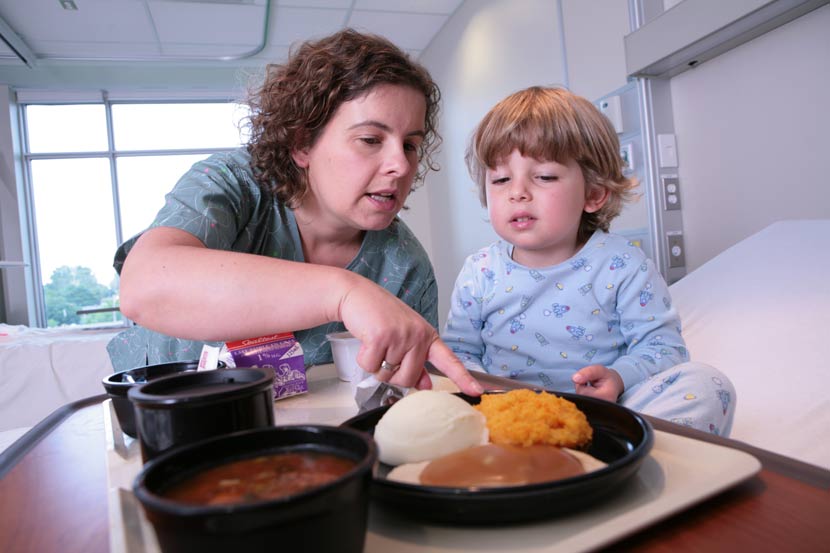Controlling Food Waste and Increasing Patient Satisfaction
Controlling food costs and expenses within the foodservice department in a hospital can be very challenging. Food waste contributes to these expenses, therefore FSMs/FSSs are always trying to find ways to reduce the amount of waste. When food waste occurs, and trays come back with untouched food, or an excessive amount of uneaten food, many staff members may think that the patients do not like the food. This is because the reputation for hospital food has always been negative in the past. However, there are many factors that contribute to patient dissatisfaction and food waste, but it is not because the food tastes bad! Below are some tips to improve patient satisfaction, and decrease food waste.
Assistance/Access Related – Many patients that are within hospitals require some assistance. They may require assistance with ordering food, if they have that option, such as reading the menu, or choosing the foods that are appropriate for them. It is important for a patient to know what they are ordering, based on their likes and dislikes, and their diet type.
Patients may also need assistance with eating. It important to know which patients need feeding assistance at all times to ensure they are being fed at the appropriate times. Also, the appropriate utensils must be given to patients if they are feeding themselves to accommodate their needs. Encouragement to eat is also important to provide patients, because they may feel like eating is not important, or not needed.
When trays are delivered, it is important to ensure that the patient has easy access to the tray. Many patients are immobile, or cannot reach far enough, therefore trays are untouched due to food being placed out of the patient’s reach.
The packaging of the products, such as bottles, cartons, or plastic covered containers may be difficult for a patient to open due to lack of strength, therefore it is important to make sure the patient can easily open the products, or be given the required assistance if needed.
Environment Related– The Protected Mealtimes Initiative (PMI) is a national initiative introduced by NHS (National Health Service) Estates in 2004, as part of the Better Hospital Food Programme. This programme encourages nurses to stop all non-urgent clinical activity during mealtimes so that patients can eat their meals without interruptions and nursing staff are available to offer help to those who need it. Many patients are interrupted at meals for clinical reasons, such as taking a medication, or being given a needle, which disrupts them from eating, and may cause them to stop eating. It is important for all staff members to follow this initiative, to improve patient satisfaction.
The positioning of the patient is also important to check to make sure they are comfortable enough to be able to eat. They may not have the strength to adjust themselves, therefore assistance may be required. Also, the patient should have enough room and space around them to be able to eat.
All patients are very different, therefor some may want privacy when eating a meal, or some may want to sit in a dining room surrounded by others so they can socially interact with one another. It is important to make sure the patient eats in the environment they prefer, to increase consumption of food.
Meal-Service Related – When meals are being delivered, there are many things that could happen that will interfere with patient food consumption. Delivery of a meal when the patient is not in the room will affect the temperature of the food if it is left sitting in their room until they return, which will be a safety hazard for the patient since the food may be within the danger zone. They will also not want to eat hot food that is now cold, therefor it is important to know when a patient will be out of their room, and their return time. When the patient is in their room, it is important to let them know their meal has arrived.
When in a dining room setting, serving patients closely together is important because one patient does not want to watch another eat. This may make them think the serving is unfair, and will turn them off from eating. Also, if they are being assisted with eating, it is important to give them sufficient time that they need. Patients do not want to be rushed, or they will not want to eat again based on previous experiences. It may also be a safety issue if they are fed too fast.
The presentation of their meal may also have an impact on food consumption. The setup of the meal should be visually attractive, and well organized. The saying “We eat with our eyes” is true in many cases, including within a healthcare setting. It should include the food the patient has ordered, if applicable, or food that accommodates their diet type. It should be evenly set up, and not over filled or under filled.
Overall, when patients do not consume their meals, it contributes to food waste, which impacts the food costs and expenses. Initially, people think it is because hospital food is disgusting, and patients dissatisfied and are not eating because they do not like the food. However, that is not the case. Assistance, environment and meal-Service related issues all play a role in the increased amount of food waste and patient dissatisfaction. By following the tips above, a facility will be able to control their food costs and increase patient satisfaction within a healthcare setting.

